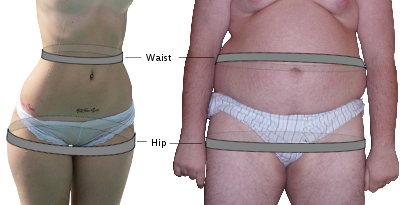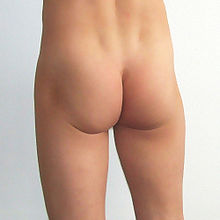- Waist–hip ratio
-
 Measurement of waist hip ratio: In a lean person (left), the waist can be measured at its narrowest point, while for a person with convex waist (right), it may be measured at about one inch[1] above the navel. The hip is measured at its widest portion of the buttocks at left, and at the great trochanters at right, although the object cheats a bit by not having his legs close together.
Measurement of waist hip ratio: In a lean person (left), the waist can be measured at its narrowest point, while for a person with convex waist (right), it may be measured at about one inch[1] above the navel. The hip is measured at its widest portion of the buttocks at left, and at the great trochanters at right, although the object cheats a bit by not having his legs close together.
 The waist-hip ratio in women is often considered a key feature in physical attractiveness. Measured directly from this image, the frontal WHR of the woman in this image is approximately 0.68.
The waist-hip ratio in women is often considered a key feature in physical attractiveness. Measured directly from this image, the frontal WHR of the woman in this image is approximately 0.68.
Waist–hip ratio or waist-to-hip ratio (WHR) is the ratio of the circumference of the waist to that of the hips.

Contents
Measurement
WHO STEPS
Accoding to WHO STEPS the waist circumference should be measured at the midpoint between the lower margin of the least palpable rib and the top of the iliac crest, using a stretch‐resistant tape that provides a constant 100 g tension. Hip circumference should be measured around the widest portion of the buttocks, with the tape parallel to the floor.
For both measurements, the subject should stand with feet close together, arms at the side and body weight evenly distributed, and should wear little clothing. The subject should be relaxed, and the measurements should be taken at the end of a normal expiration. Each measurement should be repeated twice; if the measurements are within 1 cm of one another, the average should be calculated. If the difference between the two measurements exceeds 1 cm, the two measurements should be repeated.[2]
Practical measurement
Practically, however, the waist is more conveniently measured simply at the smallest circumference of the natural waist, usually just above the belly button, and the hip circumference may likewise be measured at its widest part of the buttocks or hip.[3] Also, in case the waist is convex rather than concave, such as is the case in pregnancy and obesity, the waist may be measured at a horizontal level 1 inch above the navel.[1]
Indicator of health
The WHR has been used as an indicator or measure of the health of a person, and the risk of developing serious health conditions. Research shows that people with "apple-shaped" bodies (with more weight around the waist) face more health risks than those with "pear-shaped" bodies who carry more weight around the hips.
WHR is used as a measurement of obesity, which in turn is a possible indicator of other more serious health conditions.
WHO STEPS states that abdominal obesity is defined as waist–hip ratio above 0.90 for males and above 0.85 for females, or a BMI above 30.0.[4]
The National Institute of Diabetes, Digestive and Kidney Diseases (NIDDK) states that women with waist-to-hip ratios of more than 0.8 are at increased health risk because of their fat distribution. And that men with waist-to-hip ratios of more than 1.0 are at increased health risk because of their fat distribution.[5]
A WHR of 0.7 for women and 0.9 for men have been shown to correlate strongly with general health and fertility. Women within the 0.7 range have optimal levels of estrogen and are less susceptible to major diseases such as diabetes, cardiovascular disorders and ovarian cancers (tenuous).[6] Men with WHRs around 0.9, similarly, have been shown to be more healthy and fertile with less prostate cancer and testicular cancer.[7]
WHR has been found to be a more efficient predictor of mortality in older people than waist circumference or body mass index (BMI).[8] If obesity is redefined using WHR instead of BMI, the proportion of people categorized as at risk of heart attack worldwide increases threefold.[9] The body fat percentage is considered to be an even more accurate measure of relative weight. Of these three measurements, only the waist-hip ratio takes account of the differences in body structure. Hence, it is possible for two women to have vastly different body mass indices but the same waist-hip ratio, or to have the same body mass index but vastly different waist-hip ratios.
Even in ancient civilizations globally, female representations are most often in the 0.6-0.7 range for WHR, suggesting a preference towards lower WHR.[10]
Other studies have found that waist circumference, not WHR, to be a good indicator of cardiovascular risk factors,[11] body fat distribution,[12] and hypertension in type 2 diabetes.[13]
Measure of attractiveness
The concept and significance of WHR as an indicator of attractiveness was first theorized by evolutionary psychologist Devendra Singh at the University of Texas at Austin in 1993.[14][15] Singh argued that the WHR was a more consistent estrogen marker than the Bust-waist ratio (BWR) studied at King's College, London by Dr. Glenn Wilson in the 1970s.[16][17]
Some researchers have found that the waist-hip ratio (WHR) is a significant measure of female attractiveness.[18] Women with a 0.7 WHR are usually rated as more attractive by men from Indo-European cultures.[19] Beauty icons such as Marilyn Monroe, Jayne Mansfield, Salma Hayek and Sophia Loren typically have ratios close to 0.6, even though they have different weights and heights. In other cultures, preferences appear to vary according to some studies,[20] ranging from 0.6 in China,[21] to 0.8 or 0.9 in parts of South America and Africa,[7][22][23] and divergent preferences based on ethnicity, rather than nationality, have also been noted.[24][25]
It appears that men are more influenced by female waist-size than hip-size:
"Hip size indicates pelvic size and the amount of additional fat storage that can be used as a source of energy. Waist size conveys information such as current reproductive status or health status ... in westernized societies with no risk of seasonal lack of food, the waist, conveying information about fecundity and health status, will be more important than hip size for assessing a female's attractiveness."To enhance their perceived attractiveness, some women may artificially alter their apparent WHR. The methods include the use of a corset to reduce the waist size and hip and buttock padding to increase the apparent size of the hips and buttocks. In an earlier attempt to quantify attractiveness, corset and girdle manufacturers of the 20th century used a calculation called hip spring[27] (or hip-spring or hipspring). Hip spring is calculated by subtracting the waist measurement from the hip measurement. However, this calculation fell into disuse because it is a poor indicator of attractiveness; for example, a hip spring of 10 inches (250 mm) would likely be considered quite attractive for an average-sized adult woman, but a child or petite woman with the same number would more likely be seen as malnourished.
Cognitive Ability
Using data from the U.S. National Center for Health Statistics, William Lassek at the University of Pittsburgh in Pennsylvania and Steven Gaulin of the University of California, Santa Barbara, found a child's performance in cognitive tests correlated to their mother's waist-hip ratio, a proxy for how much fat she stores on her hips.[28]
Children whose mothers had wide hips and a low waist-hip ratio scored highest, leading Lassek and Gaulin to suggest that fetuses benefit from hip fat, which contains long chain polyunsaturated fatty acids, critical for the development of the fetus's brain.[28] In addition, evidence suggests that children of low-WHR teens were protected from the cognitive deficits often associated with teen birth. Consistent with cognitive epidemiological data, numerous studies confirm that obesity is associated with cognitive deficits. [29] Whether obesity causes cognitive deficits, or vice versa is unclear at present.
See also
- Body fat percentage
- Body Volume Index
- Body mass index
- Sagittal Abdominal Diameter (SAD)
- Index of Central Obesity
- Central obesity
- Physical attractiveness
- Sexual attraction
References
- ^ a b Brown, J. E.; Potter, J. D.; Jacobs, D. R.; Kopher, R. A.; Rourke, M. J.; Barosso, G. M.; Hannan, P. J.; Schmid, L. A. (1996). "Maternal Waist-to-Hip Ratio as a Predictor of Newborn Size: Results of the Diana Project". Epidemiology 7 (1): 62–6. doi:10.1097/00001648-199601000-00011. JSTOR 3702758. PMID 8664403.
- ^ http://whqlibdoc.who.int/publications/2011/9789241501491_eng.pdf
- ^ Waist To Hip Calculator at University of Maryland Medical System. Retrieved Dec 2010
- ^ http://whqlibdoc.who.int/publications/2011/9789241501491_eng.pdf
- ^ http://www.freedieting.com/tools/waist_to_hip_ratio.htm
- ^ "The Rules of Attraction in the Game of Love". The Rules of Attraction in the Game of Love. http://www.livescience.com/health/060213_attraction_rules.html.
- ^ a b Marlowe, F; Apicella, C; Reed, D (2005). "Men's preferences for women's profile waist-to-hip ratio in two societies". Evolution and Human Behavior 26 (6): 458–68. doi:10.1016/j.evolhumbehav.2005.07.005. http://www.fas.harvard.edu/~hbe-lab/acrobatfiles/profilewhr.pdf.
- ^ Price GM, Uauy R, Breeze E, Bulpitt CJ, Fletcher AE (August 2006). "Weight, shape, and mortality risk in older persons: elevated waist-hip ratio, not high body mass index, is associated with a greater risk of death". Am. J. Clin. Nutr. 84 (2): 449–60. PMID 16895897. Lay summary.
- ^ Yusuf S, Hawken S, Ounpuu S, et al. (November 2005). "Obesity and the risk of myocardial infarction in 27,000 participants from 52 countries: a case-control study". Lancet 366 (9497): 1640–9. doi:10.1016/S0140-6736(05)67663-5. PMID 16271645.
- ^ Singh D (December 2002). "Female mate value at a glance: relationship of waist-to-hip ratio to health, fecundity and attractiveness". Neuro Endocrinol. Lett.. 23 Suppl 4: 81–91. PMID 12496738. http://faculty.bennington.edu/~sherman/sex/whr-singh2002.pdf.
- ^ Dobbelsteyn CJ, Joffres MR, MacLean DR, Flowerdew G (May 2001). "A comparative evaluation of waist circumference, waist-to-hip ratio and body mass index as indicators of cardiovascular risk factors. The Canadian Heart Health Surveys". Int. J. Obes. Relat. Metab. Disord. 25 (5): 652–61. doi:10.1038/sj.ijo.0801582. PMID 11360147.
- ^ Ketel IJ, Volman MN, Seidell JC, Stehouwer CD, Twisk JW, Lambalk CB (June 2007). "Superiority of skinfold measurements and waist over waist-to-hip ratio for determination of body fat distribution in a population-based cohort of Caucasian Dutch adults". Eur. J. Endocrinol. 156 (6): 655–61. doi:10.1530/EJE-06-0730. PMID 17535865.
- ^ Picon PX, Leitão CB, Gerchman F, et al. (April 2007). "[Waist measure and waist-to-hip ratio and identification of clinical conditions of cardiovascular risk: multicentric study in type 2 diabetes mellitus patients]" (in Portuguese). Arq Bras Endocrinol Metabol 51 (3): 443–9. PMID 17546244.
- ^ Singh D (August 1993). "Adaptive significance of female physical attractiveness: role of waist-to-hip ratio". J Pers Soc Psychol 65 (2): 293–307. doi:10.1037/0022-3514.65.2.293. PMID 8366421.
- ^ Buss, David (hardcover). The Evolution of Desire: Strategies of Human Mating (second ed.). New York: Basic Books. p. 56. http://www.human-nature.com/nibbs/04/buss.html.
- ^ Wilson, Glenn D.; Brazendale, Anthony H. (1974). "Psychological correlates of sexual attractiveness: An empirical demonstration of denial and fantasy gratification phenomena?". Social Behavior and Personality: an international journal 2: 30–4. doi:10.2224/sbp.1974.2.1.30.
- ^ Wilson, Glenn; Nias, David; Brazendale, Anthony (1975). "Vital Statistics, Perceived Sexual Attractiveness, and Response to Risque Humor". The Journal of Social Psychology 95 (2): 201–5. doi:10.1080/00224545.1975.9918705.
- ^ Perfect waist-to-hip ratio is 0.7
- ^ Singh, Devendra; Young, Robert K. (2001-06-27). "Body Weight, Waist-to-Hip Ratio, Breasts, and Hips: Role in Judgments of Female Attractiveness and Desirability for Relationships" (PDF). Ethology and Sociobiology 16 (6): 483–507. doi:10.1016/0162-3095(95)00074-7. http://web.missouri.edu/~rouderj/3010/readings/Singh.pdf.
- ^ Fisher, M.L.; Voracek M. (June 2006). "The shape of beauty: determinants of female physical attractiveness". J Cosmet Dermatol 5 (2): 190–4. doi:10.1111/j.1473-2165.2006.00249.x. PMID 17173598.
- ^ Dixson, B.J.; Dixson A.F., Li B., Anderson M.J. (January 2007). "Studies of human physique and sexual attractiveness: sexual preferences of men and women in China". Am J Hum Biol 19 (1): 88–95. doi:10.1002/ajhb.20584. PMID 17160976.
- ^ Marlowe, F.; Wetsman, A. (2001). "Preferred waist-to-hip ratio and ecology" (PDF). Personality and Individual Differences 30 (3): 481–489. doi:10.1016/S0191-8869(00)00039-8. http://www.fas.harvard.edu/%7Ehbe-lab/acrobatfiles/preferred%20waist.pdf.
- ^ Dixson, B.J.; Dixson A.F., Morgan B., Anderson M.J. (June 2007). "Human physique and sexual attractiveness: sexual preferences of men and women in Bakossiland, Cameroon". Arch Sex Behav 36 (3): 369–75. doi:10.1007/s10508-006-9093-8. PMID 17136587.
- ^ Freedman, R.E.; Carter M.M., Sbrocco T., Gray JJ. (August 2007). "Do men hold African-American and Caucasian women to different standards of beauty?". Eat Behav 8 (3): 319–33. doi:10.1016/j.eatbeh.2006.11.008. PMC 3033406. PMID 17606230. http://www.pubmedcentral.nih.gov/articlerender.fcgi?tool=pmcentrez&artid=3033406.
- ^ Freedman, R.E.; Carter M.M., Sbrocco T., Gray J.J. (July 2004). "Ethnic differences in preferences for female weight and waist-to-hip ratio: a comparison of African-American and White American college and community samples". Eat Behav. 5 (3): 191–8. doi:10.1016/j.eatbeh.2004.01.002. PMID 15135331.
- ^ Rozmus-Wrzesinska M, Pawlowski B (March 2005). "Men's ratings of female attractiveness are influenced more by changes in female waist size compared with changes in hip size". Biol Psychol 68 (3): 299–308. doi:10.1016/j.biopsycho.2004.04.007. PMID 15620796.
- ^ [1]
- ^ a b Lassek, W.; Gaulin S. (January 2008). "Waist-hip ratio and cognitive ability: is gluteofemoral fat a privileged store of neurodevelopmental resources?". Evolution and Human Behavior 29 (1): 26–34. doi:10.1016/j.evolhumbehav.2007.07.005.
- ^ doi:10.1111/j.1467-789X.2011.00920.x
This DOI appears to be broken. It may be incorrect, in which case correcting it will allow the citation to be automatically completed. Or it may not be functional, in which case you can complete the citation details by hand.
External links
- Waist-hip ratio should replace body mass index as indicator of mortality risk in older people EurekAlert August 8, 2006
- Genes for 'pear shape' found, NHS Choices, October 11, 2010
Categories:- Body shape
- Physical attractiveness
- Medical signs
- Ratios
Wikimedia Foundation. 2010.

